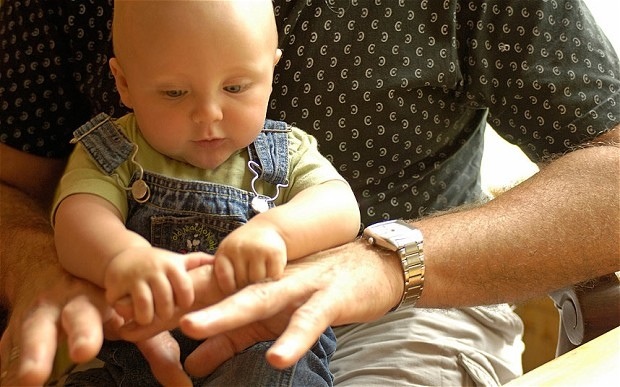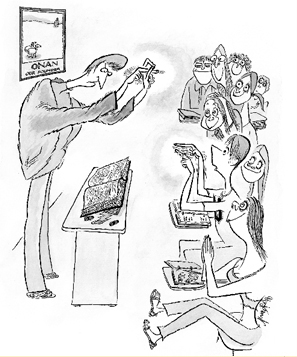Feminism 2.0
She needs to remove the label “feminism” and just call it something else. The word feminism has been too tainted and still is associated with people who only care about women. It has very little if anything to do with equality. If it did, feminism would do their best with updating domestic relations law and reforming family courts all across America.
And what is the deal with men needing to be civilized? That needs further explanation:
We hear it all the time: “America is patriarchal!”, “American women are oppressed!”. Well, a lifelong feminist and former National Organization for Women member, Tammy Bruce, is tired of hearing it–and she has a solution laid out in our newest video: Feminism 2.0. One that tells women that they should be proud to act feminine. One that tells them that simply copying men and masculine traits is actually demeaning to women. One that honors all responsible choices, including becoming a wife and mother.
Why couples don’t have sex after birth of kids

New fathers experience changes in the levels of hormones that cause them to suffer a drop in libido
Most couples will testify that their sex life plummets on the birth of a new baby, with new mothers often worrying that they are no longer seen as attractive in the eyes of their partner.
But a new study suggests that parenthood not only affects the biology of mothers but also of fathers.
During the first year new fathers experience a drop of testosterone of around one third, with those who help out with childcare for three or more hours a day seeing a further drop of 20 per cent.
The new fathers who took part in the research also reported having less sex.
Researchers believe that ‘the sensitising effect’ is driven by the psychological and cultural impulse to protect a newborn and would have the same impact on adoptive fathers.
Men with less testosterone are likely to be less aggressive and more caring. Previous research has also shown that men with high testosterone levels feel less sympathy or need to respond to the cries of a baby.
It means that new mothers should not worry about their partners straying after the birth, or feel anxious if they do not want to have sex. They are biologically programmed to concentrate on looking after their children at the expense of their sex drive.
Dr Lee Gettler, of Notre Dame, carried out the largest study of its kind looking at how the biology of new fathers changes after the birth of their children.
“It’s not just mothers who go through pregnancy and birth and it’s not just mothers who biologically respond to parenthood. Fathers can biologically respond to the needs of children too,” he said.
“We found that men who became new fathers had a decline of testosterone of between 33-34 per cent. Men who were most involved in the day to day hands on childcare had the lowest testosterone levels.
“If you think about fathers in other mammalian species they don’t really help taking care of the children.
“So it seems that natural selection has stepped up men’s hormone system to respond to the needs of their offspring.
“Our species has evolved paternal instincts which are somewhat unique to our species compared with our closest relatives.”
Read more HERE: http://www.telegraph.co.uk/science/science-news/10639631/Why-couples-dont-have-sex-after-birth-of-kids.html
Disposable Father
http://www.youtube.com/watch?v=sCNZByBU2-0
This girl and mother don’t need this man do they? Who CARES about this bum. He’s just another father who was probably a batterer right? He was probably threatening his wife and she was bound to be a victim sooner or later. Let the state handle this guy and get the mom some of the services she really needs.
This kind of story makes me FURIOUS!!!!
Three Moore Police officers were put on administrative leave while detective investigate an in-custody death from overnight. The family of the man who died said police beat him badly and they recorded it with a cell phone camera.
Nair Rodriguez and her daughter Lunahi told News 9 they got into an argument at the Warren Theater around midnight. Nair said she slapped her daughter then stormed away. Her husband, Luis, chased after her. That was when the family said officers confronted Luis Rodriguez and asked to see his identification.
According to Lunahi and Nair, he tried to bypass the officers to stop his wife from driving off because she was so angry. They said officers took him down and it escalated.
Lunahi Rodriguez said that five officers beat her father to death right in front of her, in the parking lot of the movie theater.
“When they flipped him over you could see all the blood on his face, it was, he was disfigured, you couldn’t recognize him.”
By the time it was all over, Nair Rodriguez said that she knew her husband was dead.
“I saw him. His [motionless] body when people carry it to the stretcher,” she explained. “I knew that he was dead.”
Nair says her husband was only trying to defuse the fight she was having with her daughter. She said when police asked her about it she told them what happened.
“I told them I hit her and he was just trying to reach me. Why didn’t they arrest me?”
Lunahi added, “My mom was taking a video and asking, ‘What are they doing this for? Why?’ And they didn’t give really an explanation.”
Rodriguez told News 9 that police took her phone with the recording on it. Another family member provided News 9 with an audio recording she said was taken when that happened. The family hoped Luis would pull through, so they waited for news at the hospital.
“Two hours passed. They finally called her up to say, ‘Oh you could see him,’ but it turned out it was a lie. They moved his body elsewhere,” said Lunahi.
The family told News 9 they would hire an attorney.
Why Mom’s Time Is Different From Dad’s Time

Surveys find that men and women work roughly the same number of hours a week—yet they experience their time very differently
Excerpt from this article: http://m.us.wsj.com/articles/SB10001424052702304757004579335053525792432?mobile=y
Funny: I once sat on a panel with Adam Mansbach, the author of the best-selling parody “Go the F— to Sleep.” At one point in the discussion, he conceded that his partner put his child to bed most nights. He may have written a book about the tyranny of toddlers at bedtime, but in his house, it was mainly Mom’s problem.
Complicating matters, mothers assume a disproportionate number of time-sensitive domestic tasks, whether it’s getting their toddlers dressed for school or their 12-year-olds off to swim practice. Their daily routine is speckled with what sociologists Annette Lareau and Elliot Weininger call “pressure points,” or nonnegotiable demands that make their lives, as the authors put it, “more frenetic.”
These deadlines have unintended consequences. They force women to search for wormholes in the time-space continuum simply to accomplish all the things that they need to do. In 2011, the sociologists Shira Offer and Barbara Schneider found that mothers spend, on average, 10 extra hours a week multitasking than do fathers “and that these additional hours are mainly related to time spent on housework and child care.”
When fathers spend time at home, on the other hand, it reduces their odds of multitasking by over 30%. Which may explain why, a few years ago, researchers from UCLA found that a father in a room by himself was the “person-space configuration observed most frequently” in their close study of 32 families at home. It may also explain why many fathers manage to finish the Sunday paper while their wives do not—they’re not constantly getting up to refill bowls of Cheerios.
Being compelled to divide and subdivide your time doesn’t just compromise your productivity and lead to garden-variety discombobulation. It also creates a feeling of urgency—a sense that no matter how tranquil the moment, no matter how unpressured the circumstances, there’s always a pot somewhere that’s about to boil over.
“My husband says I cause some of the worry unnecessarily,” another Minnesota mother, who was part of the same parenting program, told me when I spent some time in her home.
It’s something that I hear a lot from parents. One of them—usually the mother—is more alive to the emotional undercurrents of the household. As a result, this more intuitive parent feels that the other parent—usually the father—is not doing his fair share, while the father feels that his wife is excessively emotional and wretchedly inefficient. But what really may be going on is that the couple is experiencing time differently, because each person is paying attention to different things.
It’s important to remember that fairness isn’t just about absolute equality. It’s about the perception of equality. Women may work fewer paid hours than men, but because they devote nearly twice as much time to family care (housework, child care, shopping), it doesn’t look to women like their husbands are sharing the load evenly when they’re all home together. It looks instead like their husbands are watching “SportsCenter.”
Read the full article HERE
The Campus Rape Myth
by Heather Mac Donald, City Journal Winter 2008 – an excerpt:
It’s a lonely job, working the phones at a college rape crisis center. Day after day, you wait for the casualties to show up from the alleged campus rape epidemic—but no one calls. Could this mean that the crisis is overblown? No: it means, according to the campus sexual-assault industry, that the abuse of coeds is worse than anyone had ever imagined. It means that consultants and counselors need more funding to persuade student rape victims to break the silence of their suffering.
The campus rape movement highlights the current condition of radical feminism, from its self-indulgent bathos to its embrace of ever more vulnerable female victimhood. But the movement is an even more important barometer of academia itself. In a delicious historical irony, the baby boomers who dismantled the university’s intellectual architecture in favor of unbridled sex and protest have now bureaucratized both. While women’s studies professors bang pots and blow whistles at antirape rallies, in the dorm next door, freshman counselors and deans pass out tips for better orgasms and the use of sex toys. The academic bureaucracy is roomy enough to sponsor both the dour antimale feminism of the college rape movement and the promiscuous hookup culture of student life. The only thing that doesn’t fit into the university’s new commitments is serious scholarly purpose.
The campus rape industry’s central tenet is that one-quarter of all college girls will be raped or be the targets of attempted rape by the end of their college years (completed rapes outnumbering attempted rapes by a ratio of about three to two). The girls’ assailants are not terrifying strangers grabbing them in dark alleys but the guys sitting next to them in class or at the cafeteria.
This claim, first published in Ms. magazine in 1987, took the universities by storm. By the early 1990s, campus rape centers and 24-hour hotlines were opening across the country, aided by tens of millions of dollars of federal funding. Victimhood rituals sprang up: first the Take Back the Night rallies, in which alleged rape victims reveal their stories to gathered crowds of candle-holding supporters; then the Clothesline Project, in which T-shirts made by self-proclaimed rape survivors are strung on campus, while recorded sounds of gongs and drums mark minute-by-minute casualties of the “rape culture.” A special rhetoric emerged: victims’ family and friends were “co-survivors”; “survivors” existed in a larger “community of survivors.”
An army of salesmen took to the road, selling advice to administrators on how to structure sexual-assault procedures, and lecturing freshmen on the “undetected rapists” in their midst. Rape bureaucrats exchanged notes at such gatherings as the Inter Ivy Sexual Assault Conferences and the New England College Sexual Assault Network. Organizations like One in Four and Men Can Stop Rape tried to persuade college boys to redefine their masculinity away from the “rape culture.” The college rape infrastructure shows no signs of a slowdown. In 2006, for example, Yale created a new Sexual Harassment and Assault Resources and Education Center, despite numerous resources for rape victims already on campus.
If the one-in-four statistic is correct—it is sometimes modified to “one-in-five to one-in-four”—campus rape represents a crime wave of unprecedented proportions. No crime, much less one as serious as rape, has a victimization rate remotely approaching 20 or 25 percent, even over many years. The 2006 violent crime rate in Detroit, one of the most violent cities in America, was 2,400 murders, rapes, robberies, and aggravated assaults per 100,000 inhabitants—a rate of 2.4 percent. The one-in-four statistic would mean that every year, millions of young women graduate who have suffered the most terrifying assault, short of murder, that a woman can experience. Such a crime wave would require nothing less than a state of emergency—Take Back the Night rallies and 24-hour hotlines would hardly be adequate to counter this tsunami of sexual violence. Admissions policies letting in tens of thousands of vicious criminals would require a complete revision, perhaps banning boys entirely. The nation’s nearly 10 million female undergrads would need to take the most stringent safety precautions. Certainly, they would have to alter their sexual behavior radically to avoid falling prey to the rape epidemic.
None of this crisis response occurs, of course—because the crisis doesn’t exist. During the 1980s, feminist researchers committed to the rape-culture theory had discovered that asking women directly if they had been raped yielded disappointing results—very few women said that they had been. So Ms.commissioned University of Arizona public health professor Mary Koss to develop a different way of measuring the prevalence of rape. Rather than asking female students about rape per se, Koss asked them if they had experienced actions that she then classified as rape. Koss’s method produced the 25 percent rate, which Ms.then published.
Koss’s study had serious flaws. Her survey instrument was highly ambiguous, as University of California at Berkeley social-welfare professor Neil Gilbert has pointed out. But the most powerful refutation of Koss’s research came from her own subjects: 73 percent of the women whom she characterized as rape victims said that they hadn’t been raped. Further—though it is inconceivable that a raped woman would voluntarily have sex again with the fiend who attacked her—42 percent of Koss’s supposed victims had intercourse again with their alleged assailants.
All subsequent feminist rape studies have resulted in this discrepancy between the researchers’ conclusions and the subjects’ own views. A survey of sorority girls at the University of Virginia found that only 23 percent of the subjects whom the survey characterized as rape victims felt that they had been raped—a result that the university’s director of Sexual and Domestic Violence Services calls “discouraging.” Equally damning was a 2000 campus rape study conducted under the aegis of the Department of Justice. Sixty-five percent of what the feminist researchers called “completed rape” victims and three-quarters of “attempted rape” victims said that they did not think that their experiences were “serious enough to report.” The “victims” in the study, moreover, “generally did not state that their victimization resulted in physical or emotional injuries,” report the researchers.
Read the rest HERE: http://www.city-journal.org/2008/18_1_campus_rape.html

